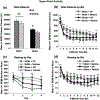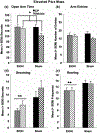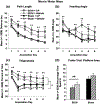The effects of alcohol and cannabinoid exposure during the brain growth spurt on behavioral development in rats
- PMID: 30854806
- PMCID: PMC7749758
- DOI: 10.1002/bdr2.1487
The effects of alcohol and cannabinoid exposure during the brain growth spurt on behavioral development in rats
Abstract
Cannabis is the most commonly used illicit drug among pregnant women. Moreover, over half of pregnant women who are consuming cannabis are also consuming alcohol; however, the consequences of combined prenatal alcohol and cannabis exposure on fetal development are not well understood. The current study examined behavioral development following exposure to ethanol (EtOH) and/or CP-55,940 (CP), a cannabinoid receptor agonist. From postnatal days (PD) 4-9, a period of brain development equivalent to the third trimester, Sprague-Dawley rats received EtOH (5.25 g/kg/day) or sham intubation, as well as CP (0.4 mg/kg/day) or vehicle. All subjects were tested on open field activity (PD 18-21), elevated plus maze (PD 25), and spatial learning (PD 40-46) tasks. Both EtOH and CP increased locomotor activity in the open field, and the combination produced more severe overactivity than either exposure alone. Similarly, increases in thigmotaxis in the Morris water maze were caused by either EtOH or CP alone, and were more severe with combined exposure, although only EtOH impaired spatial learning. Finally, developmental CP significantly increased time spent in the open arms on the elevated plus maze. Overall, these data indicate that EtOH and CP produce some independent effects on behavior, and that the combination produces more severe overactivity in the open field. Importantly, these data suggest that prenatal cannabis disrupts development and combined prenatal exposure to alcohol and cannabis may be particularly damaging to the developing fetus, which has implications for the lives of affected individuals and families and also for establishing public health policy.
Keywords: behavior; cannabinoid; development; ethanol; teratology.
© 2019 Wiley Periodicals, Inc.
Figures







Similar articles
-
Altered motor development following late gestational alcohol and cannabinoid exposure in rats.Neurotoxicol Teratol. 2019 May-Jun;73:31-41. doi: 10.1016/j.ntt.2019.03.005. Epub 2019 Mar 31. Neurotoxicol Teratol. 2019. PMID: 30943441 Free PMC article.
-
Adolescent Choline Supplementation Attenuates Working Memory Deficits in Rats Exposed to Alcohol During the Third Trimester Equivalent.Alcohol Clin Exp Res. 2016 Apr;40(4):897-905. doi: 10.1111/acer.13021. Alcohol Clin Exp Res. 2016. PMID: 27038598 Free PMC article.
-
Early developmental alcohol exposure alters behavioral outcomes following adolescent re-exposure in a rat model.Alcohol Clin Exp Res. 2022 Nov;46(11):1993-2009. doi: 10.1111/acer.14950. Epub 2022 Sep 30. Alcohol Clin Exp Res. 2022. PMID: 36117379 Free PMC article.
-
Prenatal cannabinoid exposure and altered neurotransmission.Neuropharmacology. 2019 May 1;149:181-194. doi: 10.1016/j.neuropharm.2019.02.018. Epub 2019 Feb 13. Neuropharmacology. 2019. PMID: 30771373 Review.
-
Developmental consequences of perinatal cannabis exposure: behavioral and neuroendocrine effects in adult rodents.Psychopharmacology (Berl). 2011 Mar;214(1):5-15. doi: 10.1007/s00213-010-1892-x. Epub 2010 Jun 17. Psychopharmacology (Berl). 2011. PMID: 20556598 Free PMC article. Review.
Cited by
-
The Effects of Cannabis on Female Reproductive Health Across the Life Course.Cannabis Cannabinoid Res. 2021 Aug;6(4):275-287. doi: 10.1089/can.2020.0065. Epub 2020 Dec 28. Cannabis Cannabinoid Res. 2021. PMID: 33998877 Free PMC article.
-
A Systematic Review of the Effects of Perinatal Alcohol Exposure and Perinatal Marijuana Exposure on Adult Neurogenesis in the Dentate Gyrus.Alcohol Clin Exp Res. 2020 Jun;44(6):1164-1174. doi: 10.1111/acer.14332. Epub 2020 May 14. Alcohol Clin Exp Res. 2020. PMID: 32246781 Free PMC article.
-
Consequences of Perinatal Cannabis Exposure.Trends Neurosci. 2019 Dec;42(12):871-884. doi: 10.1016/j.tins.2019.08.010. Epub 2019 Oct 8. Trends Neurosci. 2019. PMID: 31604585 Free PMC article. Review.
-
Effects of prenatal alcohol and delta-9-tetrahydrocannabinol exposure via electronic cigarettes on motor development.Alcohol Clin Exp Res. 2022 Aug;46(8):1408-1422. doi: 10.1111/acer.14892. Epub 2022 Jul 26. Alcohol Clin Exp Res. 2022. PMID: 35722858 Free PMC article.
-
Synaptic signatures of perinatal cannabinoids: A systematic review of rodent hippocampal synaptic plasticity, learning, and memory.Drug Alcohol Depend Rep. 2025 Jun 25;16:100353. doi: 10.1016/j.dadr.2025.100353. eCollection 2025 Sep. Drug Alcohol Depend Rep. 2025. PMID: 40678750 Free PMC article. Review.
References
-
- Abel E, & Subramanian M (1990). Effects of low doses of alcohol on delta-9-tetrahydrocannabinol’s effects in pregnant rats. Life Sciences, 47(18), 1677–1682. - PubMed
-
- Abel E, Tan S, & Subramanian M (1987). Effects of Δ9-tetrahydrocannabinol, phenobarbital, and their combination on pregnancy and offspring in rats. Teratology, 36(2), 193–198. - PubMed
-
- Abel EL, Rockwood GA, & Riley EP (1986). The effects of early marijuana exposure In Handbook of Behavioral Teratology (pp. 267–288). Boston, MA: Springer.
-
- Barnett SA (1963). The rat: A study in behavior. Chicago, IL: Routledge.
-
- Barron S, Tiernan SB, & Riley EP (1988). Effects of prenatal alcohol exposure on the sexually dimorphic nucleus of the preoptic area of the hypothalamus in male and female rats. Alcoholism: Clinical and Experimental Research, 12(1), 59–64. - PubMed
Publication types
MeSH terms
Substances
Grants and funding
LinkOut - more resources
Full Text Sources
Miscellaneous

